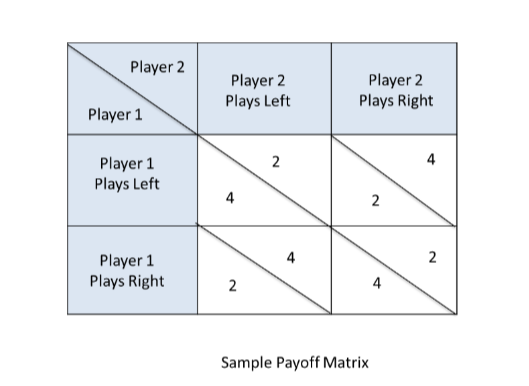GerBL Games
Welcome to this experiment on interactive choice behavior, or, as it is better known, Game Theory. In these games each player's choices alter the consequence of the other player's choices.
Let's take an example. Suppose that Player 1 selects Left. This choice might then provide Player 2 with two points if he also selects Left and 4 points if he picks Right. If Player 1, instead of Left were to choose Right, then the consequences for Player 2's choices might be reversed: a response to the Left would get 4 points and a response to the Right would get two points.
This relationship works both ways: Player 2's choices also alter the points Player 1 receives for each of his choices.
We can describe this interaction of consequences in something called a Payoff Matrix. This matrix shows the outcome of each possible combination of choices. Every game of Game Theory can be described by its own unique Payoff Matrix. Here's one that summarizes the game we started to describe.

In this game there is no combination of choices upon which the players might be expected to agree. Whenever one gets the most points (4) the other gets the fewest (2). If Player 1 picks Left and Player 2 plays Right, then Player 1 gets 2 points and Player 2 gets 4, and so on. There's no combination that provides 4 points for both players.
But this is not true of most of the games of Game Theory. On the next page, you will be able to choose a game from a list of some of the most popular 2-player games. In six of these games, you have just two choices (left and right); in two you and your partner will have three choices (left, center and right). As you play one or another of these games, you will both be going through a joint learning process. In most of the games your choices will gradually mutually gravitate to that combination that works best for you both. You will arrive at the choice combination that gives neither of you any better option - given the choice of the other player. This combination is termed the game's Nash Equilibrium after the mathematician John Nash.
When you are finished you will receive the results of your game. You will see your game's particular payoff matrix and you will be able to see how your performance compares to that predicted by theory. Thank you for your interest and thank you for serving as a subject in this ongoing experiment.
John V. Keller, Ph.D.